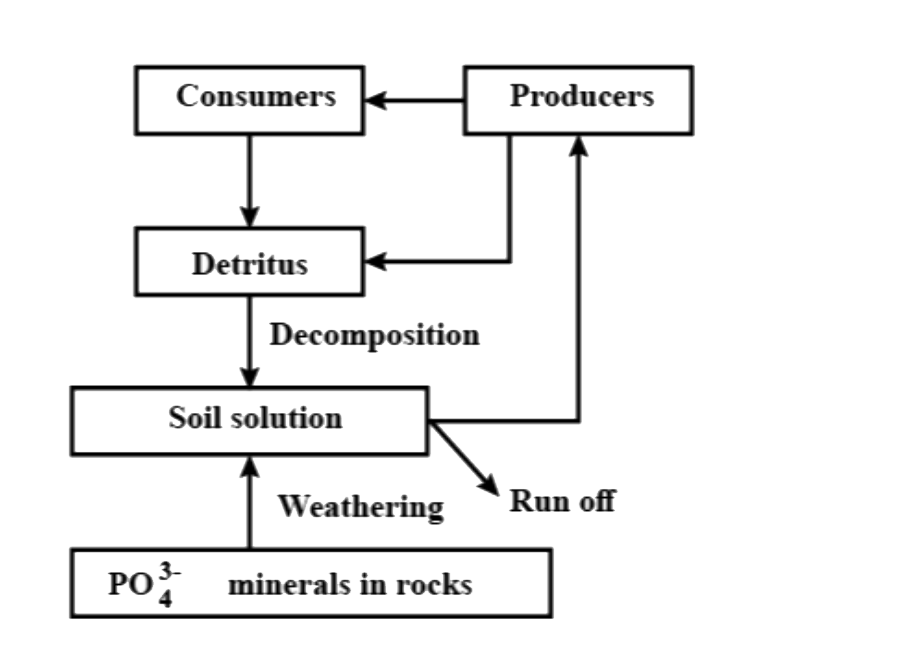Why are nutrient cycles in nature called biogeochemical cycles?
Step-by-Step Solution:
1. Definition of Nutrient Cycles: Nutrient cycles refer to the natural processes through which essential nutrients are recycled in the ecosystem. These nutrients include carbon, nitrogen, phosphorus, and others that are vital for the survival of living organisms.
2. Introduction to Biogeochemical Cycles: The term "biogeochemical" combines three components: "bio" refers to living organisms, "geo" refers to the earth (rocks, soil), and "chemical" refers to the chemical elements and compounds involved in the cycles.
3. Transfer of Nutrients: Nutrients (in the form of ions or molecules) are transferred from the environment (which includes rocks, air, and water) to living organisms (the biotic components of the ecosystem). This transfer is crucial for the growth and development of organisms.
4. Cyclic Nature of Nutrient Flow: After being utilized by organisms, these nutrients are eventually returned to the environment in a cyclic manner. This means that the process is continuous, with nutrients moving from the environment to organisms and back again.
5. Components of Biogeochemical Cycles: The biogeochemical cycles involve interactions between living organisms (bio), the physical environment (geo), and the chemical processes that facilitate the movement of nutrients. This interconnectedness is what characterizes the cycles as "biogeochemical."
6. Conclusion: Therefore, nutrient cycles are called biogeochemical cycles because they encompass the biological (living organisms), geological (earth), and chemical (nutrient processes) aspects of nutrient transfer and recycling in nature.
Topper's Solved these Questions
- ECOSYSTEMBOOK - NCERT EXEMPLAR ENGLISHCHAPTER - ECOSYSTEMEXERCISE - Short Answer Type Question
16 Videos
- ECOSYSTEMBOOK - NCERT EXEMPLAR ENGLISHCHAPTER - ECOSYSTEMEXERCISE - Long Answer Type Question
12 Videos
- ECOSYSTEMBOOK - NCERT EXEMPLAR ENGLISHCHAPTER - ECOSYSTEMEXERCISE - Long Answer Type Question
12 Videos
- BIOTECHNOLOGY PRINCIPLES AND PROCESSBOOK - NCERT EXEMPLAR ENGLISHCHAPTER - BIOTECHNOLOGY PRINCIPLES AND PROCESSEXERCISE - All Questions
44 Videos
- ENVIRONMENTAL ISSUES BOOK - NCERT EXEMPLAR ENGLISHCHAPTER - ENVIRONMENTAL ISSUES EXERCISE - Long Answer Type Questions
7 Videos
Similar Questions
Knowledge Check
Which one of the following is not a gaseous biogeochemical cycle in ecosystem?
AWater cycleBPhosphorus cycleCNitrogen cycleDCarbon cycle
The cause of water cycle in nature is :
View SolutionThe diagram/flow chart represents which of the sedimentary biogeochemical cycle ?

(a) Nitrogen cycle
(b) Phosphorus cycle
(c) Oxygen cycle
(d) Sulphur cycle
View SolutionState the function of a reservoir in a nutrient cycle. Explain the simplified model of carbon cycle in nature.
View SolutionState the function of a reservoir in a nutrient cycle. Explain the simplified model of carbon cycle in nature.
View SolutionExplain the oxygen cycle in nature.
View SolutionWhat is a biogeochemical cycle. What is the role of the reservoir in a biogeochemical cycle? Give an example of a sedimentary cycle with reservoir located in earth's crust.
View SolutionWhich one of the following is not a gaseous biogeochemical cycle in ecosystem?
View Solution
